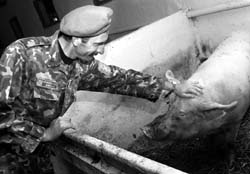Reforms on the Border

It is hard to believe that hazing is unheard-of at a border post where between thirty and forty men work shoulder to shoulder day in and day out. After all, this is not some army squad or unit. The Day’s correspondent saw it first hand at a recent gathering — the first in Ukraine’s independent history — of 300 top specialists of Ukraine’s State Border Service (the official name of Ukraine’s Border Guard since August 1) on the premises of the Cherkasy Training Unit in Orshanka.
According to State Border Service First Deputy Chief cum Personnel Department Director Lt. Gen. Mykhailo Koval, the guard is undergoing a transition from a military formation to a law enforcement structure with special status. This fundamentally changes approaches to state border protection. The State Border Service is a law enforcement structure directly subordinated to the president. It has discarded the linear formation of service, along with obsolete forms and methods of state border protection. Greater emphasis is placed on extending the network of border service inspectors, border patrols, increasing the strength of operations units, giving priority to obtaining early information, technical re-equipment, and the service’s supply of information at all levels. There are plans to further expand information databases and improve data transfer networks. Moreover, new standards are being developed for border checkpoints. To illustrate, checks can be performed jointly with the State Customs Service, which helps simplify customs and frontier formalities. There are plans to transfer the border guard to a contract basis before 2005.
On the first day of the gathering the results of the State Border Service activity in the nine months of 2003 were summed up. Top brass from border units and commandants’ offices and chiefs of border details shared their experience in protecting the border. As State Border Service Chief Mykola Lytvyn said in his address, it is the border posts, checkpoints, and commandants’ offices that ensure the reliability of protecting the state border. According to Border Service top brass, illegal migration and contraband are the major threat to Ukraine’s border security. The reasons behind this are the economic plight faced by Ukraine and its post-Soviet neighbors and poverty of the residents of frontier regions, whom criminals draw into their illegal dealings. Since the beginning of the year the Border Service has performed six cross-border operations and scores of local operations, detained 2,450 persons, confiscated forty kilograms of drugs, and 226 firearms. As a result, 1,486 persons have been brought to account.
Most illegal migrants enter Ukraine crossing the northwestern sections of the border with Russia and Belarus. Meanwhile, migrants leave Ukraine crossing the western sections of the border with Slovakia, Poland, and Hungary. Most illegal migrants are Chinese and Syrians. Meanwhile, cigarettes and alcohol, gasoline, meat, sugar, and cars are the most popular contraband items. Naturally, the smugglers do not schew illegal drugs. Most drugs have been seized at the border with Russia (76%) and Moldova (14%), with 30% of all drugs confiscated from the residents of frontier regions.
In an interview with The Day, junior inspector of the Izmayil Trade Port state border section Oksana Kovalchuk said, “The exchange of experience is very useful. Personally I found it very interesting to learn about my colleagues’ work at other checkpoints and border posts. I will certainly share my impressions with my colleagues.” Incidentally, Oksana’s brother Oleksandr is also a border guard officer. He manages the training department of the Izmayil unit. Service in the border guards has become a tradition in the Kovalchuk family, with the father of the family in his twenty-seventh year of service. His children believe it is prestigious to protect the border. And although the father did not want Oksana to join the force, it was her childhood dream. After a two- year stint as a police officer, she does not regret having become a border guard. Women make up half of her unit’s strength. In her view, their careers do not get in the way of their personal life, as many are married with children.
During the meeting the guests were shown how to teach service organization and self-defense to border guards. Great emphasis is placed on physical training, with 70% of all training time devoted to hand-to-hand combat practice. All barracks are equipped with sports gear used by the border guards to hone their skills in their free time. Incidentally, they invariably place high in all- Ukrainian hand-to-hand combat competitions among representatives of the uniformed services. In particular, according to the 2002 hand-to-hand combat champion of the border guard, 1st Lt. Oleksiy Zorin, the Cherkasy Unit team includes Candidates to Master of Sports in kickboxing Borys Kozlovsky and Serhiy Yakushev, as well as Master of Sports in kickboxing and hand-to- hand combat and first-degree black belt in karate Artem Boiko.
Guests were also shown the farm of the border guards. Just like other uniformed services they do not count on budgetary funding alone.






